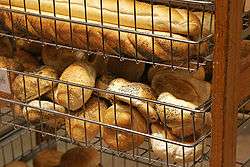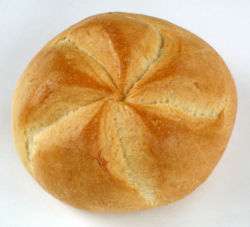Bread roll
 Bread rolls (lower bin) at a bakery | |
| Type | Bread |
|---|---|
| Course | Side dish |

A roll is a small, often round loaf of bread served as a meal accompaniment (eaten plain or with butter).[1] A roll can be served and eaten whole or cut transversely and dressed with filling between the two halves. Rolls are also commonly used to make sandwiches similar to those produced using slices of bread. They are found in most cuisines all over the world. In the Deipnosophistae, the author Athenaeus (c.A.D.170 – c. 230) describes some of the bread, cakes, and pastries available in the Classical world.[2] Among the breads mentioned are griddle cakes, honey-and-oil bread, mushroom-shaped loaves covered in poppy seeds, and the military specialty of rolls baked on a spit.
Europe
Even in the same languages rolls are known by a variety of names. In Ireland and parts of England, a soft roll is called a bap.
Rolls are common in Europe, especially in Germany, Austria, Switzerland, Sweden, Finland, Denmark, Norway, Italy, Hungary, the United Kingdom and other countries with a thriving bread culture.
Other European languages have many local and dialectal terms for bread rolls. These include German language diminutives of Brot (bread) in most of western and central Germany (where they are called Brötchen) and in Switzerland (where they are called Brötli). Other German language terms include Rundstück ("round piece") in Hamburg and Schleswig-Holstein;[3] Semmel in Austria and southern Bavaria; Weck in much of Baden-Württemberg, Franconia and Saarland; Schrippe in Berlin and parts of Brandenburg. Some of these names reappear in other European languages as well, for example as zsemle in Hungarian, or rundstykker ("round pieces") in Danish and Norwegian.
"Small bread" is also found as Italian panino, but which commonly denotes a very specific kind of Tramezzino sandwich bread. The Kaisersemmel reappears in Italy as the Michetta or Rosetta. In Swedish, a bread roll is a (frukost) bullar ("(breakfast) buns"), franskbrödbullar ("french bread bun") or simply fralla ("bun"), comfort food eaten with butter and any kind of topping (marmalade, cheese, ham, salami) for special weekend breakfasts. The Doppelweck or Doppelbrötchen is a type of bread roll originating from the Saarland which consists of two rolls joined together side-by-side before baking.
A variety of rolls are found in Europe, from white rolls made with wheat flour, to dark rolls containing mostly rye flour. Many variants include spices, such as coriander and cumin, or nuts. Also common are bread rolls containing or garnished with whole seeds such as sesame, poppy, pumpkin or sunflower.
Preparation
Below are the steps in the preparation of a Czech bread roll called "houska".
- Bread roll preparation
- 1. The prepared dough ready for cutting
- 2. Division into small pieces
- 3. Equipment for slicing dough into equal parts
- 4. Equipment for pressing rolls into shape
- 5. Pressing produces the characteristic shape of the roll.
- 6. The conveyor belt transports the pressed dough
- 7. Sprinkling the rolls with water
- 8. Sprinkling sesame seeds
- 9. Freshly baked rolls are removed from the oven.
See also
References
- ↑ Stein, Sadie (April 13, 2015). "Ode to the Buttered Roll, That New York Lifeline". The New York Times. Retrieved November 30, 2017.
- ↑ Chrysippus of Tyana gives a list of thirty kinds, without commentary (Toussaint-Samat 2009, p. 202).
- ↑ www.abendblatt.de: Hamburger Rundstück (in German)
External links

